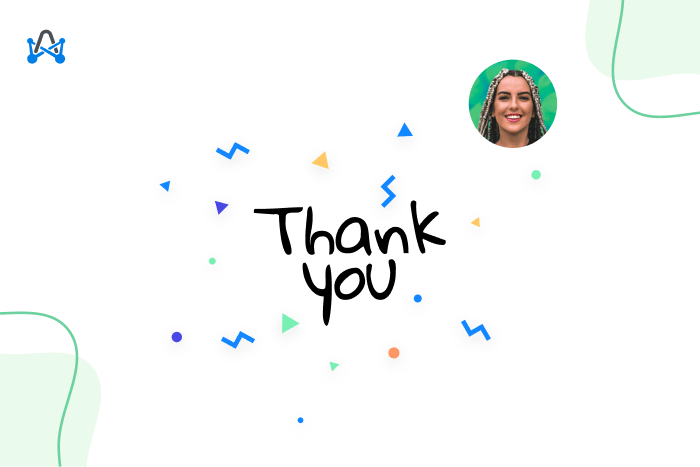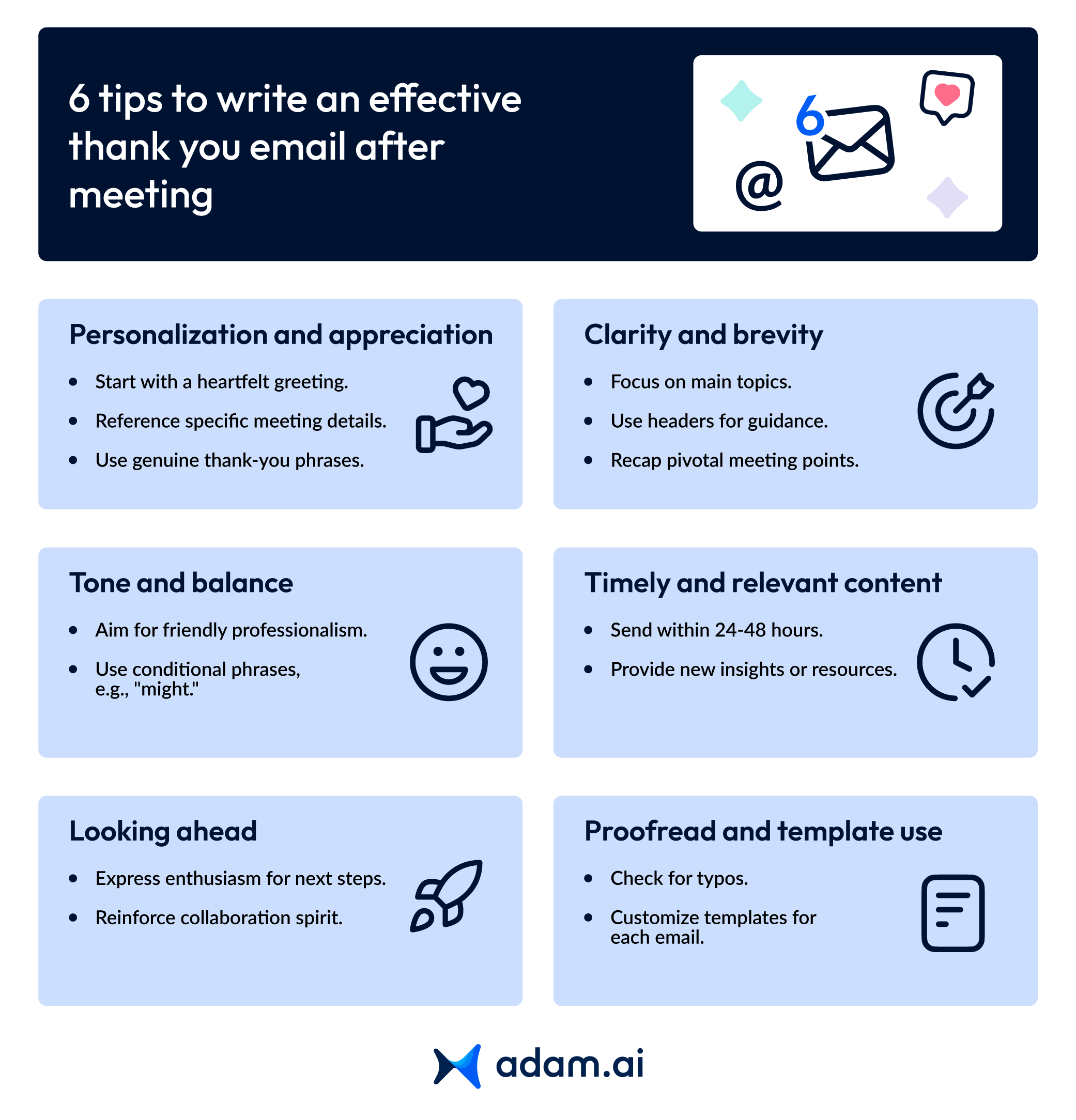April 6, 2022 · 8 min read
How to Write an Effective Thank You Email after Meeting

Mary Nour

Some call it a thank you email after meeting; others call it a business meeting follow-up email. Whatever the name is, this kind of email has one purpose, "keeping the conversation going and building rapport."
Whether you are sending this email to your team, client, or a decision-maker in a company, people like to feel appreciated for taking time out of their day to do something.
Besides thanking the meeting attendees, in a thank you email, you get the chance to find common grounds, summarize important points of the meeting, and add a call to action.
Sounds good? Let's dig into how you can write an effective thank you email after meeting.
To write a thank you email that makes a remarkable impact, we recommend your email has the following five parts.
Part one: writing a good email subject line
Email subject lines can always be used to display how witty and genuine you are. It's best if you replace generic subject lines with attention-grabbing ones. You can choose lines that relate to something unique that happened in the meeting or compliment the meeting participant.
Part two: expressing gratitude
It goes without saying, “thank you” is an essential part of your email. However, we had to mention it because a heartfelt thank you and a true appreciation have a huge impact on people.
There is a difference between just saying thank you and really meaning it. Sentences like “it was great meeting you today” and “I truly appreciate the time you took out of your calendar to meet me today” can resonate with people. So, make sure you're genuine and honest when expressing gratitude.
Part three: finding a common ground
Thank-you emails shouldn’t look like pre-written templates. Personalization is key when writing a compelling thank you email after meeting.
And this can be achieved when you find a genuine common ground with the other person. People relate to each other better if there is a common ground and you can easily earn their trust.
When you find something in common, the conversation will follow naturally, and you can kick off a great business relationship.
A common ground could be as simple as sharing the same interests, expressing how you like something about them or their taste, or mentioning something they posted that interested you.
Part four: a recap
Providing key takeaways is super helpful. When you reiterate key points discussed in the meetings, you ensure that everyone is on the same page. This also reflects how productive the meeting was and that you have a clear understanding of what has been communicated.
Part five: next steps
This is especially important if you are sending out this letter to a team. In this part, you can assign tasks with deadlines, so everyone knows what they are responsible for. Or you can ask them to schedule another meeting if needed.
Now that you know how to write an effective follow-up email, check out the following section.
When to send a thank you email after meeting
Sending a thank-you email promptly after a meeting underscores your professionalism and ensures your message leaves a lasting impression.
It's advisable to dispatch this note of appreciation within 24 hours, benefiting from the meeting’s impact while it remains vivid in the recipient's memory.
This timeframe can make a marked difference in a fiercely competitive market, where every touchpoint matters.
However, there are circumstances where patience might serve better; for instance, if the meeting was a job interview, it would be prudent to wait until the company's decision has been communicated before sending a thank you email.
Yet, as a general guideline, extending thanks through an email within a day of most business meetings remains a commendable practice.
Tips on writing a thank you email after meeting
When writing an effective follow-up email after a meeting, several principles stand out. Here's a streamlined guide that merges and highlights the most salient points.

What to avoid when writing a thank you email after meeting
I cannot clearly state that these are mistakes, but there are some points you better avoid when crafting your email. There is no right or wrong; these are only best practices based on research, open rates, feedback, and tons of analyzed emails.
Don't write a long thank you email
Don't deal with a thank you email after meeting as if it's a meeting minutes document. A thank you email after meeting is not the place to include every detail about the meeting. The email's purpose is a heart-felt thank you, a quick recap of the essential points and meeting objectives, and stating the next steps with a call to action, for example, scheduling a follow-up meeting.
Wrong name spelling
Make it a point to always double-check names before sending out your email. Don’t assume how names are spelled. You can either ask for their business card or their LinkedIn profile. Writing correct names shows how thoughtful and detail-oriented you are.
Poor spelling and grammatical mistakes
In today’s world, with the enormous number of options to correct your text, sending an email with spelling and grammatical mistakes just screams that you don’t care. Spelling and grammatical mistakes will work against you and the impression you want to make. Add proofreading to your checklist before sending a thank you email.
Not taking care of the placeholder text
Using thank you email templates is great and makes it easier to send out a thank you email after the meeting. But don’t make the mistake of leaving the placeholder text (custom fields). Leaving symbols like {!FirstName} will weaken the purpose of the email. It'll look like you’re sending the same generic email to everyone.
Meeting follow-up email templates
Now check out the following follow-up email samples we compiled from different resources. You can see that they include the five parts we mentioned earlier.
Follow up email after a team meeting (source: Spark)
Subject: Launching the new website: Meeting recap
Hi team,
Thanks, everyone, for a productive meeting this morning. We’ve agreed on launching a separate website for [Product name].
Here are the next steps we need to take:
- Finalize the wording and positioning: [Responsible person]
- Create the Home page structure: [Responsible person]
- Prepare a design for the Home page: [Responsible person]
- Make the list of other pages we need: [Responsible person]
The next meeting is on Friday, November 8 at 11 AM.
Please let me know if you need help with anything.
Best,
[Your name]
Follow up email after a conference or networking event (source: HubSpot)
Hi [First Name,]
So glad we got to meet at [Event]. I checked out your website afterward and loved your take on creating high-performance teams. Have you tried using the [Recommendation]? I use that framework with my team and it has been incredibly successful.
Happy to chat more about it or send over some templates and examples if you’re interested.
Again, it was great meeting you at [Name of Networking Event], and I hope to see you again soon.
[Signature]
📍 Note: You'll notice that, in the template, the focus is on two things: remind the recipient of who you are and demonstrating the value that you can bring.
Follow up email after meeting a potential customer (source: Mail Shake)
Dear ,
Thank you for taking time for a demo of our marketing automation platform. I appreciated hearing about the pain points your team faces regarding segmenting prospects; receiving feedback helps us to better understand customers’ needs and customize their experience with the platform.
I’ve attached a case study to this email regarding the success one of your fellow financial institutions experienced when fine-tuning their segmentation and creating content that resonated with their prospects.
When can we schedule a follow-up conversation with our team so we can dive into the platform’s segmentation abilities in greater detail?
I look forward to hearing from you and will follow up later this week to schedule a demo.
Thanks,
📍 Note: In follow-up email you send to potential customers, you should highlight how you can solve the customer's pain point and what value you can bring to the table. It serves you best to mention stories of similar customers you helped.
Bonus. We've recently released "The Future of Meetings Report," where over 490 experts from various industries share their insights on challenges and AI in meetings!
The bottom line
To sum up, in this article, you've learned what important parts you need to include in your thank you email after meeting and what mistakes to avoid when writing one and you went through several examples to inspire you.
When sent after conducting productive meetings, a thank you email after meeting has an even richer impact. Productive meetings have well-constructed meeting agendas and useful pre-reads. And the more agile you go through your meeting requirements, the more productive your meetings are. For example, you need to easily assign tasks, vote on recommendations, take notes, and link meetings if you are creating a series.
With the importance of creating meeting agendas, a few editable templates can make your job a lot easier.
Editable meeting agenda templates
You can find a list of useful meetings agenda templates on our blog, which can guide you to hold effective meetings:
1. Team meeting agenda template
2. Board team meeting agenda template
3. Quarterly planning meeting agenda template
4. Standup meeting agenda template
5. First meeting with new team agenda template
6. Brainstorming meeting agenda template
7. Skip-level meeting agenda template
8. Kick off meeting agenda template
9. Sales team meeting agenda template
10. Retrospective meeting agenda template
11. Status meeting agenda template
A meeting management software, like adam.ai, is second-to-none when it comes to managing your meeting workflow and helping you easily execute all of the above in one secure platform. Most importantly, adam.ai has a wide range of app integrations that makes productive meetings hassle-free.
Transform how you conduct critical meetings—From meticulous preparation to effective execution and insightful follow-up, adam.ai integrates comprehensive analytics, full customization, and intuitive interfaces with powerful meeting management tools.
Easy onboarding. Enterprise-grade security. 24/7 dedicated support.
And while there may be multiple meeting management solutions available, here is why adam.ai is the all-in-one meeting management platform you can trust:
- adam.ai is one of Atlassian Ventures' portfolio companies.
- In the meeting management software category on G2, adam.ai has been ranked a leader and a high performer for successive quarters in the past years.
- adam.ai has been included in the Forrester Report in the AI-enabled meeting technology landscape.
- adam.ai is trusted and used by powerful teams and organizations worldwide for all types of critical meetings, like board, committee, project management, and business development meetings.
- And most importantly, adam.ai integrates with your existing workflow, is SOC2 compliant, provides dedicated support and success, and has a free trial option.
Subscribe to adam.ai blog
Stay ahead with the latest insights—get our newest blog posts, tips, and updates sent straight to your inbox.